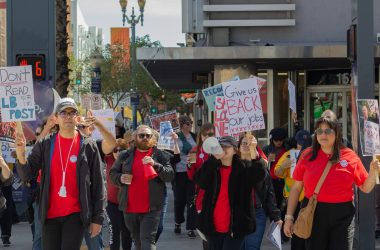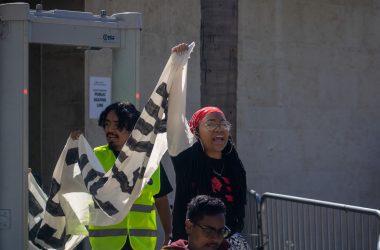Despite the continued success of Graduation Initiative 2025, California State University students and faculty were concerned about how funds are being allocated by the Board of Trustees at its meeting this Tuesday.
Graduation Initiative 2025 was first passed by the Board of Trustees in 2015 with the goal of increasing graduation rates and decreasing the number of years it takes students to get their degrees.
According to James Minor, CSU senior strategist for academic success and inclusive excellence, degree completion is currently at an all-time high in all categories. The system is on track to reach its graduation initiative goals, which includes hiring more tenure-track professors.
This January, Gov. Jerry Brown released his budget for the state, which allocated $92 million in additional funds for the CSU system.
Rafael Gómez, associate vice president for the California Faculty Association and faculty member at Cal State Monterey Bay, collaborated with students, allies and faculty members to organize demonstrations in Sacramento to call for an increase in funds. According to Gómez, these efforts led to the CSU budget increasing by an additional $364 million.
“That money was given with the expectation that it would be used to increase student enrollment and to increase the number of tenured faculty members,” Gómez said.
However, not all of the secured funds were used for increasing tenure-track faculty members or student services.
“I know faculty that are on food stamps, that are working multiple jobs besides their teaching jobs,” said Alejandro Ramirez, a CSU Chico student. “Those of you who received a pay raise and voted on the pay raise in the past have been the same people who cut classes, cut faculty positions, cut programs.”
Executive members of the CSU system and campus presidents have received pay raises each year since 2014. The average yearly salary members in such positions is $315,448.39, not including benefits. With added benefits, the salary is $456,618.59. Between 2016 and 2017, salaries not including benefits increased by an average of $28,627.34.
These numbers were calculated using Transparent California, and exclude university presidents Lynnette Zelezny, Framroze Virjee, Thomas Paraham and Eduardo Ochoa due to lack of presidential salary data. Data from BOT chair Adam Day and vice chancellor of human resources Melissa Bard were also not included due to lack of salary data.
Over 3,200 new course sections were added to the schedule this past academic year, meaning over 90,000 seats in college classrooms across the CSU system have been created, according to Minor. Due to the increase in courses, campuses are spending far more than the allocated $25 million total allocated for aggregate faculty hiring, Blanchard said.
Since campuses must maintain a certain number of faculty members in order to fill courses and numbers of retirees are expected to increase in coming years, the tenure track density cannot be a sole measure of whether campuses are hiring enough tenure faculty, chancellor Timothy White said.
“We have to pay attention to all of the moving parts,” White said. “There is no debate that permanent full-time 10-year tenure track faculty are really at the core of a strong university.”
The $25 million allocation that was given this year is going to be added to the base funds of the CSU system, Blanchard said, meaning it will continue to be added into the annual budget each year.
Thus far, the funds have been allocated on the basis of which universities have the lowest tenure densities.
The graduation initiative itself has received $150 million of $450 million estimated in permanent funding, said Loren Blanchard, executive vice chancellor of academic and student affairs.
“This year is a critical time for the success of the graduation initiatives,” Blanchard said. “Next fall, campuses will enroll the cohort of students who will reflect our six-year graduation rate in 2025.”
During the presentation of the Committee of Finance, Ryan Storm, assistant vice chancellor for budget, outlined the preliminary 2019-2020 budget proposal. The proposal included a request of a $446 to $528 million dollar total incremental budget increase.
The proposal included $75 million for Graduation Initiative 2025 and $123 to $205 million for enrollment growth.
Storm also proposed a one-time funding request of $15 million for the CSU Student Well-Being and Basic Needs Initiative. Though this budget proposal was preliminary, these numbers will help to influence the choices made by BOT members who vote to approve the request.
“The graduation initiative is one of our top priorities in the CSU, and the only way for us to maximize the investments of the GI are to address more students basic needs,” student trustee Emily Hendon, Sonoma State student, said. “Students who are experiencing food insecurity, homelessness, or both, and I can attest to both, are also experiencing physical and mental health consequences that lead to lower academic achievement, potentially pushing back time to graduation.”
According to a 2018 Study of Student Basic Needs conducted by the CSU system, 41.6 percent of students reported facing food insecurity and 10.9 percent reported experiencing homelessness within the past 12 months of the study.
“I’m facing [homelessness] right now,” San Francisco State student Nathan Carjal said during the public comment portion of the meeting. “I feel that the pay raise that the BOT and presidents got should be money that’s going to the students and not to the people who are already making six figures. My own president has free housing, and I may potentially be in the streets.”
This story has been updated for clarification Sept. 14 at 7:39 p.m. The average yearly salary reflects earnings of executive members of the CSU system as well as campus presidents, who attend Board of Trustees meetings.




